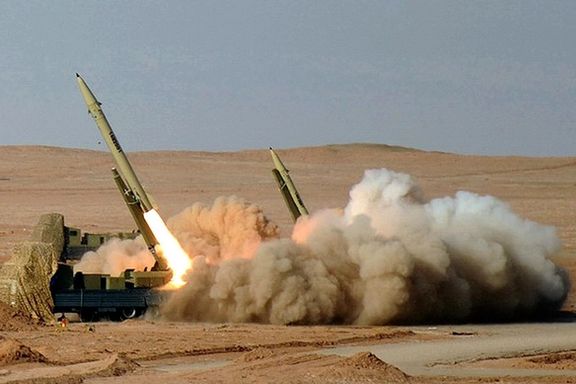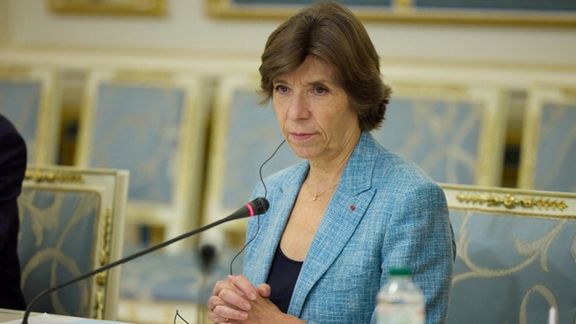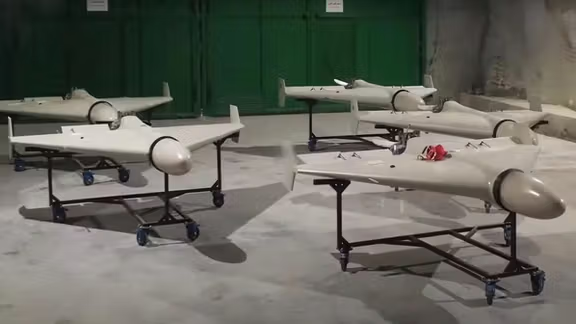In Addition To Drones, Iran Sending Missiles To Russia

In addition to supplying drones, Iran plans to send its own Fateh-110 and Zolfaghar surface-to-surface missiles to Russia for strikes on Ukrainian cities and troops.

In addition to supplying drones, Iran plans to send its own Fateh-110 and Zolfaghar surface-to-surface missiles to Russia for strikes on Ukrainian cities and troops.
In a report on Sunday, The Washington Post cited US and allied security officials as saying that the Islamic Republic is strengthening its commitment to supply arms for Russia’s assault on Ukraine.
The report claims that the increased flow of weapons from Tehran could help offset steep Russian weapons losses and rebuild the dwindling supply of precision-guided munitions for Moscow’s military.
The Post said that, according to officials from a US-allied country that closely monitors Iran’s weapons activity, Tehran dispatched officials to Russia on September 18 to finalize terms for additional weapons shipments.
The paper quoted two officials briefed about an intelligence assessment shared in recent days with Ukrainian and US officials as saying that Iran’s armaments industry is preparing a first shipment of Fateh-110 and Zolfaghar missiles, two short-range ballistic missiles capable of striking targets at distances of 300 and 700 kilometers, respectively. It would be the first delivery of such missiles to Russia since the start of the war in February.
In August, the same officials identified Iranian drones, the Shahed series and the Mohajer-6, that Tehran was supplying to Russia. The remains of both types have been recovered, analyzed and photographed by Ukrainian forces in recent weeks.
The European Union is mulling over punitive measures against Iran for its supply of drones to Russia, but despite numerous reports, the 27-nation bloc is still trying to find independent evidence for the use of the drones.

EU Foreign Policy Chief Josep Borrell reiterated calls on the Islamic Republic to stop the repression of protesters and to release those detained since the uprising began in mid-September.
In a tweet on Friday, the top EU diplomat said he spoke with Iranian Foreign Minister Hossein Amir-Abdollahian, conveying to him “EU's clear and united position: people in Iran have the right to peaceful protest and to defend fundamental rights.”
"Violent repression must stop immediately. Protesters must be released. Internet access and accountability are needed," he added.
According to unconfirmed reports, the EU is set to sanction four entities and 11 high-ranking Iranian military and security officials for their roles in the repression of the uprising, ignited by the death in custody of 22-year-old Mahsa Amini.
Also on Friday, a senior EU official said the EU foreign ministers will meet in Luxembourg on Monday to discuss the transfer of Iranian drones to Russia, noting that the ministers will not take any decisions on additional Iran sanctions but could reach a political agreement on future sanctions linked to a transfer of drones.
Despite numerous reports by the Ukrainian military about the use of the Iranian drones by the Russian forces, the 27-nation bloc is still trying to find independent evidence for the use of Tehran-supplied drones in the Russian invasion of Ukraine, the official added.
Ukraine’s President Volodymyr Zelensky said on October 10, Russia had used Iran-made drones to attack dozens of civilian targets in Ukraine. The Ukrainian military claimed on October 8 that Russia has sent Iranian military drones to Belarus for possible attacks in western or central parts of Ukraine.

The United States said Friday it was “willing and able” to impose sanctions on anyone supporting Russia’s “military-industrial complex,” possibly impacting Iran.
Deputy Treasury Secretary Wally Adeyemo, who has taken a lead on US sanctions in the administration of President Joe Biden, made the remarks as representatives of 32 countries gathered in Washington to discuss measures against Russia over the war in Ukraine.
The US has accused Iran of supplying suicide drones to Russia and Ukraine has reported several attacks by Iranian-made UAVs against infrastructure and civilian targets. Tehran has denied it has supplied any drones, but Russia and Iran remain close allies, who have fought together in Syria for seven years to save Bashar al-Assad’s regime.
During a visit to Tehran by President Vladimir Putin in July, Iran’s ruler Ali Khamenei praised the “initiative” of the Russian leader in attacking Ukraine.
The deputy secretary said Friday the Treasury Office of Foreign Assets Control (OFAC) would issue guidance making clear the US was “willing and able to sanction people, companies, or countries that provide ammunition to Russia or support Russia’s military-industrial complex.”
With Iran-Russia-trade variously reported as $2-$4 billion annually, US ‘maximum pressure’ sanctions on Tehran already threaten punitive action against any entity dealing with Iran’s financial sector. In September, the US imposed sanctions on several companies for helping or facilitating the drone transfers to Russia.
Russia is “expending munitions at an unsustainable rate,” Morgan Muir, a deputy director of national intelligence for mission integration, was due to tell Friday’s Washington gathering, Reuters reported. Since the Russian invasion of Ukraine in February, the US has sent Ukraine $16.8 billion in aid, including armored vehicles, Howitzers with 880,000 rounds, as well as Javelin anti-tank and Stinger anti-aircraft missiles.
The US has followed a graduated approach to an economic blockage of Russia, seeking to win support from allies. With Opec+, led by Russia and Saudi Arabia, recently agreeing to reduce oil output, thereby exerting upward pressure on prices, the US is working international agreement to set a price cap on Russian oil exports rather than on sanctioning buyers, Adeyemo said Wednesday.
Adeyemo told Foreign Policy in an interview published October 7 that work on sanctioning Russia began back in November 2021. He said the aim was to change Russia’s behavior: “The two places that we decided to target were Russia’s revenues in order to reduce the amount of money that they would have to prop up their economy and fund their illegitimate war in Ukraine with. And the second one was going after Russia’s military-industrial complex.”
Adeyemo conceded in the interview that Russia “and any other actor” would find ways to evade sanctions, so requiring new US “targeting.” He played down the refusal of many countries to go along with US sanctions, suggesting “the US relationship with India [for example] is as close as it’s ever been.”

France said Thursday that supply of Iranian armed drones to Russia would breach UN Security Council Resolution (UNSC) 2231 endorsing the 2015 Iran nuclear deal.
Foreign Ministry spokesperson Anne-Claire Legendre made the claim in an online briefing, saying Paris had noted “a great deal of information that reports the use of Iranian drones by the Russian armed forces in Ukraine, in bombardments that were aimed at civilian targets…”
With European Union foreign ministers due to consider Monday plans for sanctions on Iran over treatment of domestic protests, Legendre said Paris was also coordinating with “European partners” on how to respond to the “potential transfer” of Iranian drones to Russia.
Iran has denied supplying drones to Russia, and there was no immediate explanation of the French claim. Following the terms of United Nations Security Council (UNSC) Resolution 2231 and the 2015 Iran nuclear agreement, the JCPOA (Joint Comprehensive Plan of Action), a UN arms embargo on Iran expired in 2020 with a remaining ban on “any activity related to ballistic missiles designed to be capable of delivering nuclear weapons” in place until October 2023.
Reuters news agency cited “a diplomatic source” explaining Legendre’s claim in terms of drones violating UNSC Resolution 2231 because they came under the Missile Technology Control Regime (MTCR), which is a non-binding political understanding among states, including Russia and the United States, limiting proliferation of missiles and missile technology. Reuters did not explain the relevance of the MTCR nor whether it would similarly cover the current supply of drones to Ukraine from Turkey.
NATO counties seem to be taking seriously reports that Russia is using Iranian-made Shahed 136 delta-wing ‘kamikaze’ drones, which are a cheap alternative to missiles. Ukrainian officials claimed Thursday Iranian drones were responsible for explosions near the capital Kyiv early that day, with Russian strikes across the country killing 13 people in attacks on “critical infrastructure.” Associated Press reported from Kyiv that it was not clear if any of these casualties were due to drones.
Oleksiy Kuleba, head of the Kyiv military administration, said last week that explosions at a military base 75km south of the city wounding one, had been carried out by Shahed-136 drones.
Military supplies, escalation
The reported use of Iranian drones comes as Ukraine lobbies Washington for advanced weapons, including F-16 jets and long-range drones. Ukraine is meeting opposition from senior US officials concerned that striking targets well inside Russia would escalate the current conflict. There are also other reasons why sending more advanced weapons would not be easy. US officials recently told the New York Times that Ukraine, despite denials, was responsible for the August 20 bomb killing Darya Dugin, 29-year-old daughter of the Russia conservative commentator Aleksandr Dugin.
The US has so far sent $16.8 billion in military supplies to Ukraine, and the European Union $2.5 billion. Ankara has supplied Ukraine since 2019 with advanced Bayraktar TB-2 drones, while also acting in the current conflict as a mediator between Moscow and Kyiv.
Meanwhile, Republican and some Democrat critics of the JCPOA argue that protests in Iran require tougher US sanctions. Pressed by journalists Wednesday, Ned Price, the State Department spokesman said efforts to renew the JCPOA were “not our focus right now.” The US, like the three Western European JCPOA signatories – France, Germany, and the United Kingdom – say they want the JCPOA restored but that Tehran has thwarted talks by making demands beyond the 2015 agreement, which the US left in 2018 imposing ‘maximum pressure’ sanctions.

France said Thursday that any sale of Iranian drones to Russia is a violation of the UN Security Council resolution that endorsed the 2015 nuclear accord, the JCPOA.
The French foreign ministry announced that it was coordinating with EU partners on how to respond, while earlier the Ukrainian officials said three Iranian-made drones were used by Russia to attack the small town of Makariv overnight targeting critical infrastructure.
"There was an overnight drone bombardment by invaders on the Makariv community," Andriy Nebytov, head of the Kyiv region police said. Russia had used more than 20 Iranian drones in its large-scale bombardment of infrastructure and cities on October 10, Ukraine said.
According to the United States, Iran has supplied Shahed 136 suicide drones to Russia and Ukraine has reported swarms of these UAVs launched against civilian targets. The drones have a low speed of 120-150km per hour and many have been shot down by Ukrainian air defenses and warplanes.
On Tuesday, October 11, President of Ukraine Volodymyr Zelensky said Russia has ordered 2,400 Iranian-made Shahed drones from the Islamic Republic.
Diplomatic efforts to reach a solution to the Iranian nuclear issue culminated in the Joint Comprehensive Plan of Action (JCPOA) on 14 July 2015 by China, France, Germany, Russia, the United Kingdom, the United States, the High Representative of the European Union (the E3/EU+3) and the Islamic Republic of Iran. On 20 July 2015, the Security Council unanimously adopted resolution 2231 endorsing the JCPOA.

Ukrainian officials said Thursday that three Iranian-made drones were used by Russia to attack the small town of Makariv overnight targeting critical infrastructure.
"There was an overnight drone bombardment by invaders on the Makariv community," Andriy Nebytov, head of the Kyiv region police said on the Telegram messaging app.
"According to preliminary information, there were no casualties." Russia used more than 20 Iranian drones in its large-scale bombardment of infrastructure and cities on October 10, according to Ukraine.
According to the United States, Iran has supplied Shahed 136 suicide drones to Russia and Ukraine has reported swarms of these UAVs launched against civilian targets. The drones have a low speed of 120-150km per hour and many have been shot down by Ukrainian air defenses and warplanes.
Kyrylo Tymoshenko, the deputy head of Volodymyr Zelenskiy's presidential office, said earlier that the attack took place by "kamikaze drones on critical infrastructure facilities", without providing further detail.
Nebytov and the region's governor, Oleksiy Kuleba, said that rescuers were working at the site.
Makariv, a town which had a population of about 10,000 before Russia's invasion in Ukraine in February, is about 55 km (34 miles) west of the capital, Kyiv.
Iran denies supplying the drones to Russia, while the Kremlin has not commented.